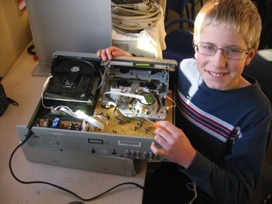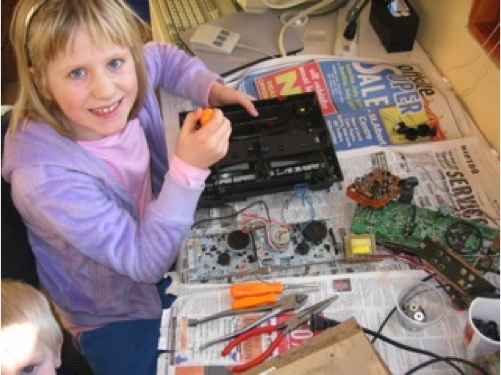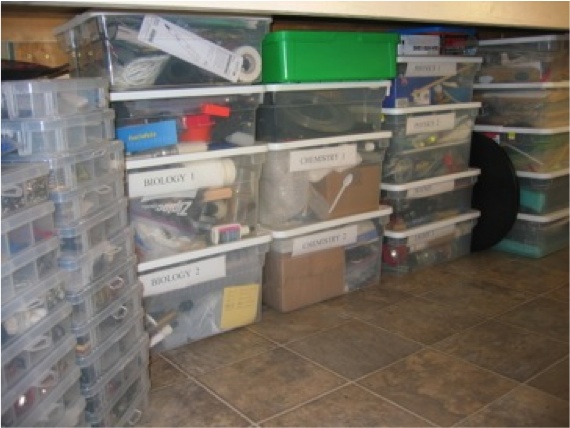How many containers do you need to fill a science program? Peculiar question, huh? Perhaps I should ask: How many weekends does it take to fill your science program containers?
Better yet… do you have enough items to fill your science containers? Um, let me try again. Do you have enough science program to fill your schedule? Do you have enough schedule open to fill a science program with? Maybe you have had just about enough of my questions. One of the hurdles in starting and keeping a home school science program moving smoothly is to be organized. Being organized helps to make the best use of a short time (I think we all know this principle).When we began building our home school science program, I looked beyond the selection of curriculum. I did look at the curriculum. Not just one year’s worth, but the whole spectrum of what might be studied – from Grade One through to the end of Grade Twelve. I even considered what I felt was lacking in the published programs. What I mean is that I took a look at the ‘things’ – the equipment – as well as the topics, that would help to make a science program intriguing and understandable. Initially, I
 considered the many ‘science kits’ that are available. I soon came to realize that most of what was being sold for a goodly sum could easily be collected around the home or found locally for cheap. Then came the realization… we first needed containers into which to collect all those items that would eventually be used in our science program. Thus began our journey into teaching the sciences and technologies to our children.Starting a science program by selecting a few sturdy transparent containers with snap-top lids was easy. Filling them was the next step. Here is the approach that we have taken:Evaluate your curriculum options and make your curriculum choices.Add your own specific areas of focus (talk to your children to learn their interests – ask them often, as interests grow).Review your choices to determine what items will be needed to complement your science program.
considered the many ‘science kits’ that are available. I soon came to realize that most of what was being sold for a goodly sum could easily be collected around the home or found locally for cheap. Then came the realization… we first needed containers into which to collect all those items that would eventually be used in our science program. Thus began our journey into teaching the sciences and technologies to our children.Starting a science program by selecting a few sturdy transparent containers with snap-top lids was easy. Filling them was the next step. Here is the approach that we have taken:Evaluate your curriculum options and make your curriculum choices.Add your own specific areas of focus (talk to your children to learn their interests – ask them often, as interests grow).Review your choices to determine what items will be needed to complement your science program.
Make a running list of items needed for each science subject stream. Keep the list nearby so that you can add to the list when new ideas come to mind.Prepare containers for each subject stream (e.g. biology, chemistry, physics, etc.) and for specific topics (e.g. light, sound, electronics, etc.).As you find needed or useful items, put them into the right container.Finding the needed items was actually much easier than I thought.  We have come to enjoy our weekends because they have become times of discovery. That is, we discover many interesting things on our visit to the dump or the recycle station. A major portion of our science equipment comes from ‘recycled technology’. By building a positive relationship with our dump operator, we benefited by his helpfulness. He would ‘watch’ for things that were on our list, and he would even retrieve such items from other dumps.
We have come to enjoy our weekends because they have become times of discovery. That is, we discover many interesting things on our visit to the dump or the recycle station. A major portion of our science equipment comes from ‘recycled technology’. By building a positive relationship with our dump operator, we benefited by his helpfulness. He would ‘watch’ for things that were on our list, and he would even retrieve such items from other dumps.
Here are some of the interesting things that you may find in junked items:Broken binoculars are a source of glass prisms and glass lenses.Microwave ovens have very large magnets. They also have glass tables useful in chemistry.VCRs and tape players have electric motors.DVD read-write drives have miniature electric motors and laser diodes. Older electronic equipment has… electronic components! (i.e. of the size that can be de-soldered and experimented with.) Compact film cameras have zenon strobe flashes. Photo-copiers have ‘perfect’ mirrors (and a whole bunch of LED’s, switches, electromagnets, gears, sheet glass, etc.) Printers have rollers, shafts and stepper motors. The metal pile  has tubes, beams, small engines, etc. We have even found telescopes and microscopes in repairable condition! Some items are worth purchasing. Depending on your children’s educational interests, these may include procuring specialty glass-ware for chemistry, a quality microscope for biology, spring-scales for physics, etc. Building up our own science ‘kits’ has taken about two or three years of occasional browsing. It has been a lot of fun discovering some really neat stuff! The process became an activity highlight for our children. Now, with all these items contained in quickly accessible containers, we can explore technology and scientific experiments without hindrance. This makes the science program flow smoothly and we have a lot of fun! The children’s interests are stimulated so that they are often asking to ‘do more science’. The equipment is there – now they are able to explore much on their own. Don’t delay! There is still time to salvage your science program! (Pun intended!)
has tubes, beams, small engines, etc. We have even found telescopes and microscopes in repairable condition! Some items are worth purchasing. Depending on your children’s educational interests, these may include procuring specialty glass-ware for chemistry, a quality microscope for biology, spring-scales for physics, etc. Building up our own science ‘kits’ has taken about two or three years of occasional browsing. It has been a lot of fun discovering some really neat stuff! The process became an activity highlight for our children. Now, with all these items contained in quickly accessible containers, we can explore technology and scientific experiments without hindrance. This makes the science program flow smoothly and we have a lot of fun! The children’s interests are stimulated so that they are often asking to ‘do more science’. The equipment is there – now they are able to explore much on their own. Don’t delay! There is still time to salvage your science program! (Pun intended!)

